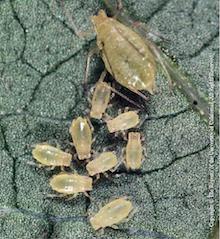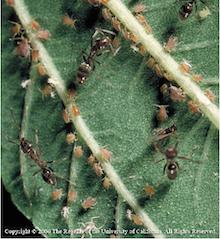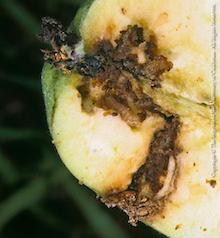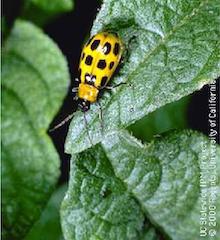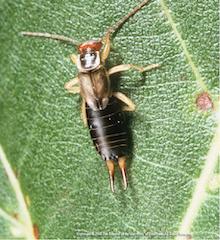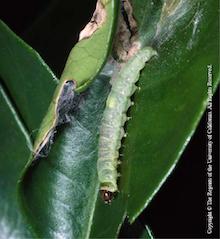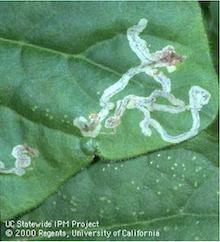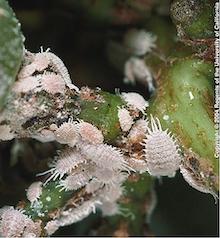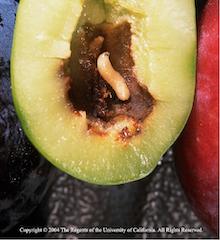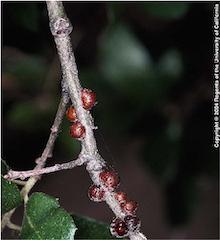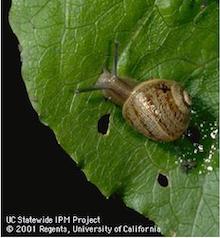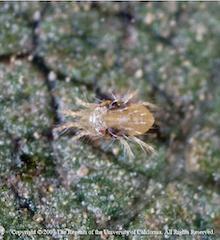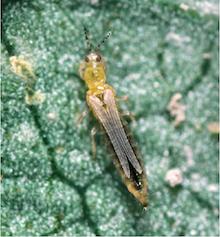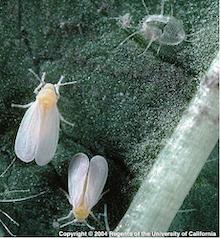| Aphids are small, soft-bodied insects that may be green, yellow, brown, red, or black in color, depending on their diet. Signs of aphid damage include their sticky honeydew exudate, sooty mold growing on the honeydew, cast skins, and distortion of leaves and shoots. Aphids are common in gardens and may be protected by ants that feed on honeydew. They rarely kill plants and can usually be washed off with water. Read more about aphids here. |
Ants become pests in gardens and landscapes when they feed on the sugary honeydew excreted by other insects that suck plant sap. Because they rely on them for food, ants protect aphids, mealybugs, soft scales, whiteflies and others, and harass or kill parasites and predators that might otherwise control honeydew producers. Read more about ants here. |
Coddling moth is the infamous “worm in the apple". These moth larvae that overwinter as cocoons and pupate into adults in spring to lay eggs. Soon after hatching, the larvae bore into apples, pears, or walnuts to feed, leaving reddish-brown droppings (frass). They feed until mature and drop to the ground to overwinter in the soil or debris, or under tree bark. Read more about coddling moth here. |
| Cucumber beetles are sometimes confused with the beneficial lady beetle but have longer antennae and may be striped or spotted, green or yellow, depending upon species. These beetles feed on leaves in vegetable gardens and may also attack ripening stone fruit. While older plants may withstand cucumber beetle attacks without significant damage, younger plants are more susceptible. Read more about cucumber beetles here. |
Earwigs, small dark insects recognizable by their prominent tail pincers, will chew holes in leaves, flowers, and fruits and can seriously damage vegetable seedlings. But they also play a beneficial role in the garden by feeding on aphids and other insect pests. Earwigs feed at night and hide during the day in dark, cool, moist places in the yard or within flowers or vegetables. Read more about earwigs here. |
Leaf feeding caterpillars, the larvae of butterflies and moths, damage plants by chewing on leaves, flowers, shoots, and fruit. Caterpillars hidden in rolled leaves or among foliage can be difficult to see. For help identifying caterpillars, see common caterpillars, flower and vegetable caterpillars, and woody plant caterpillars. Read more about managing caterpillars here.
|
| Leaf miners in the home garden are often the larvae of small black flies with a yellow triangle between the base of their wings. Leaf miners attack many different vegetable and flower hosts. The adults insert their eggs into leaves and the larvae feed between leaf surfaces, creating the twisting trails or "mines" visible from the leaf surface. Read more about leaf miners here. |
Mealy bugs are small, soft, wax-covered insects found on houseplants and on outdoor plants in areas with mild winters. They live in groups or colonies but are sometimes hard to see because they live in protected areas of the plant. Mealybugs suck plant sap, weakening the plant, and often produce sticky honeydew which can cover leaves and encourage growth of sooty mold. Read more about mealy bugs here. |
Olive fruit fly is a small fly found on olives. It is discernable from other fruit flies by the presence of black spots on the wing tips and the lack of banding across the wings. The larvae (maggots) of the olive fruit fly feed inside the fruit, consuming the pulp and allowing the entry of secondary bacteria and fungi that rot the fruit and degrade the quality of the oil. Read more olive fruit flies here.
|
| Scale are immobile insects that suck plant juices from many types of trees, shrubs, and houseplants. They may be recognized as circular, elongate or oval discolorations or raised areas on bark, leaves or fruit. Damage resembles that of aphids and white flies including sticky honeydew, black sooty mold growing on the honeydew, and discolored, distorted or dying leaves, twigs, or branches. Read more about scale insects here. |
Snails and slugs are common in gardens but because they feed at night and hide during the day, they may not be noticeable. Go out at night or in the early morning to find them in plain view. They are quite damaging and will chew holes in leaves and flowers of many garden plants. Other pests may cause similar damage but slugs and snails will leave behind shiny slime trails. There are many ways to keep slugs and snails under control in your garden. Read more about snails and slugs here. |
Spider mites are common pests of fruit trees, vegetables, berries, vines, and ornamental plants. They live in colonies, mostly on the under-surfaces of leaves but are tiny and difficult to see. Spider mites cause damage by sucking sap from leaves. Tell-tale signs of spider mites include leaves stippled with white dots and when numbers are high, dense webbing covering leaves, twigs and fruit. Read more about spider mites here. |
Stink bugs are shield-shaped with a large triangle (scutellum) on their backs that excrete fluid with an unpleasant odor when disturbed. They use their sucking mouth parts to attack a variety of fruits, nuts, and vegetables, causing blemishes, dark pinpricks, and other discoloration. Damaged tissues become pithy and white and remain firm instead of developing their normal color and tasty texture. Read more about stink bugs here.
|
Thrips are elongate, slender, minute (less than 1/20 inch long), and thus extremely difficult to see. They feed by puncturing the outer layer of plant tissue and sucking out the cell contents, which results in stippling, discolored flecking, or silvering of the leaf surface and very noticeably affecting plant appearance. Thrips rarely kill or threaten the survival of trees and shrubs but their damage can be unsightly. Read more about thrips here. |
Whiteflies are tiny, sap-sucking insects that fly around plants when disturbed. Adults are white and may have darker markings on their wings, while the nymphs (immature stage) are oval, legless, and stationary. Whiteflies use their piercing, needlelike mouthparts to suck plant sap, causing leaves to turn yellow, appear dry, or fall off. Whiteflies excrete a sugary liquid called honeydew, so leaves may be sticky or covered with black sooty mold that grows on honeydew. Read more about whiteflies here.
|

